#Bukit Lawang North Sumatra
Explore tagged Tumblr posts
Text
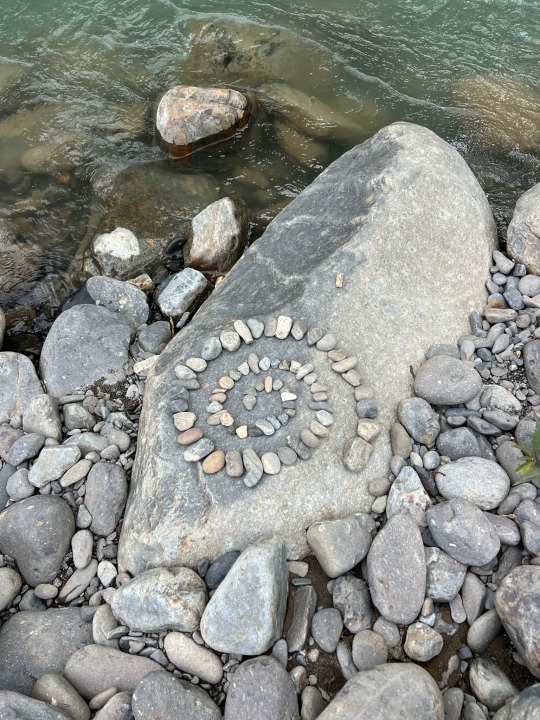

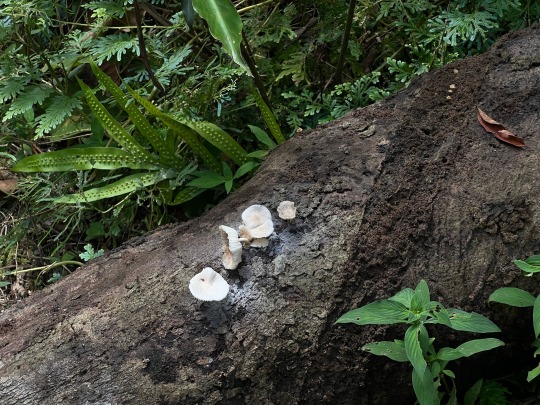
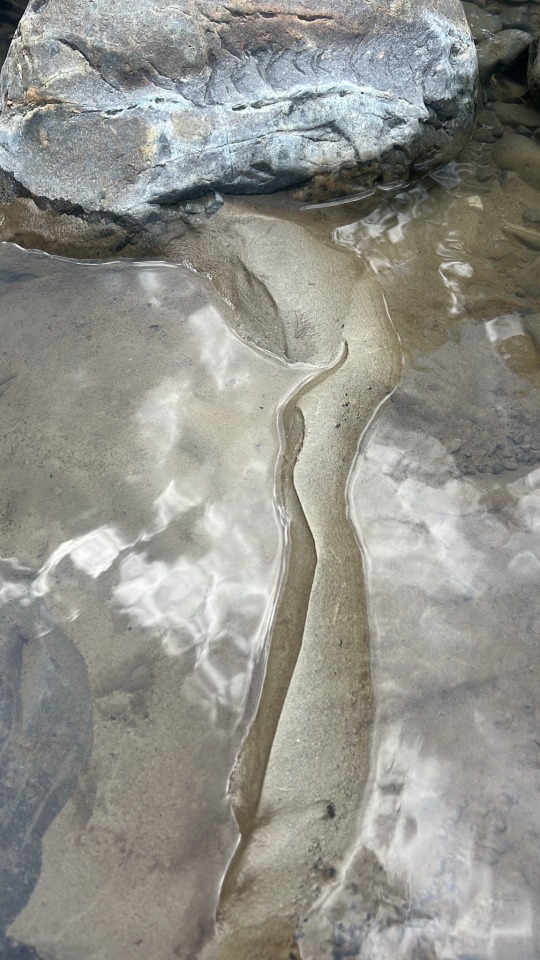
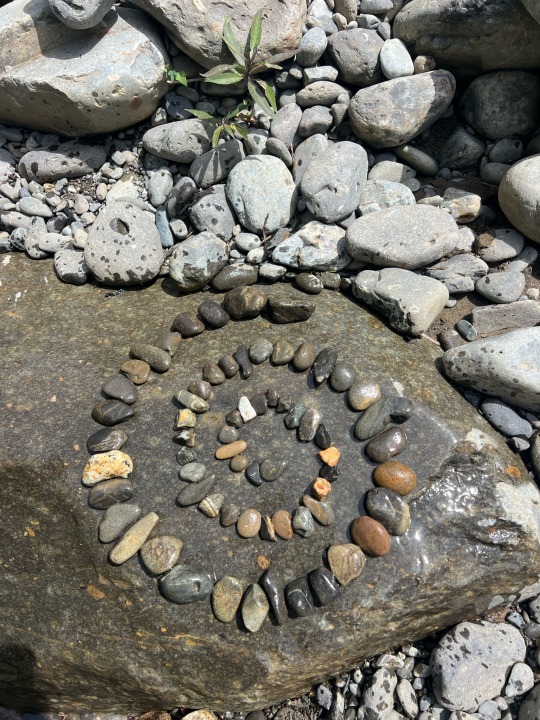

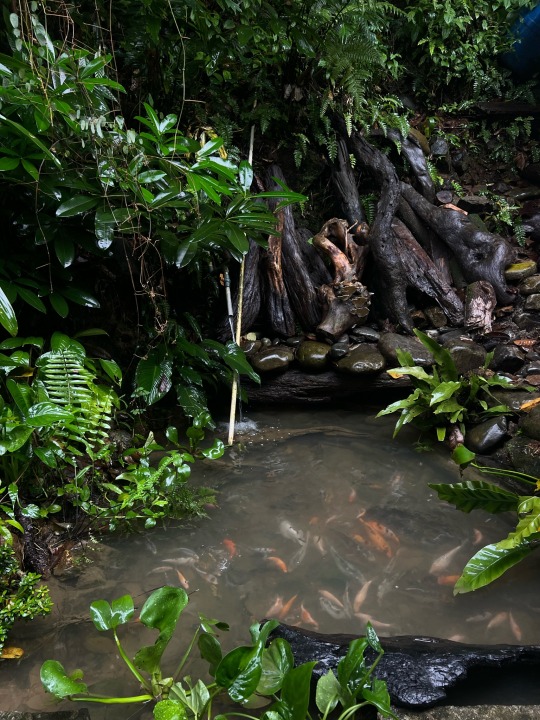
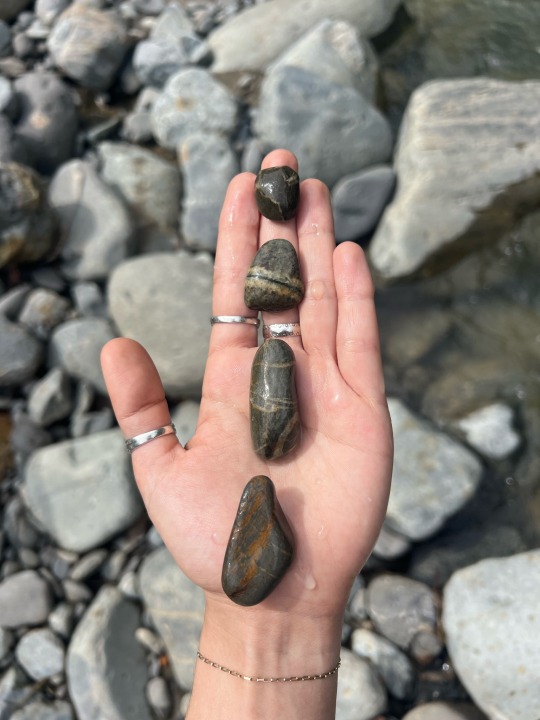
My second home, Bukit Lawang. August 2024
0 notes
Text
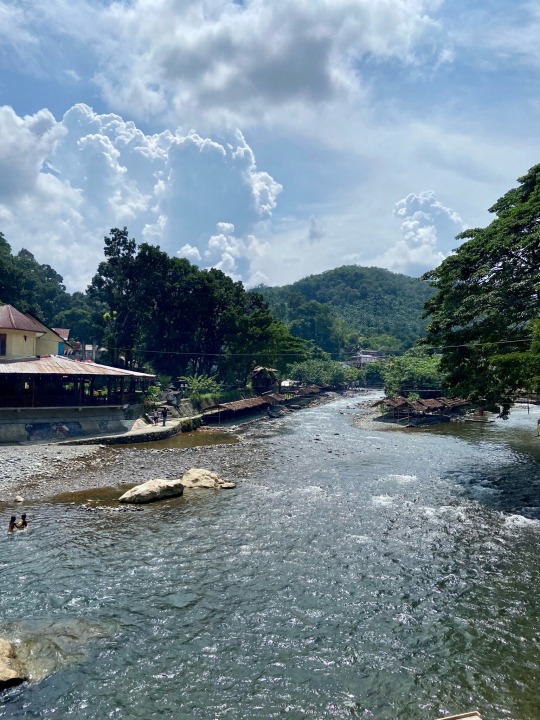
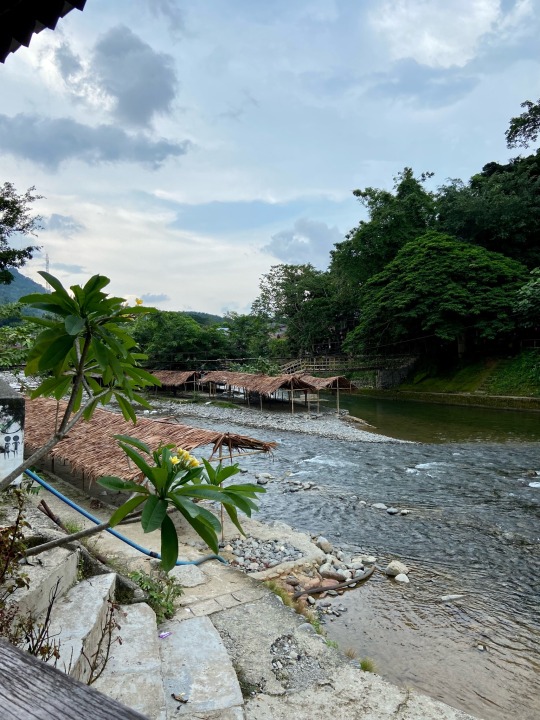

2 notes
·
View notes
Text
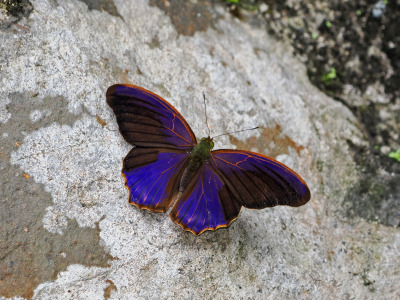
#Royal Assyrian (Terinos terpander) in Bukit Lawang#North Sumatra#Indonesia.#Source: inaturalist.org
0 notes
Text

Zamarada Geometer Moth (Zamarada sp.), family Geometridae, Bukit Lawang, North Sumatra, Indonesia
photograph by Nicky Bay
842 notes
·
View notes
Photo
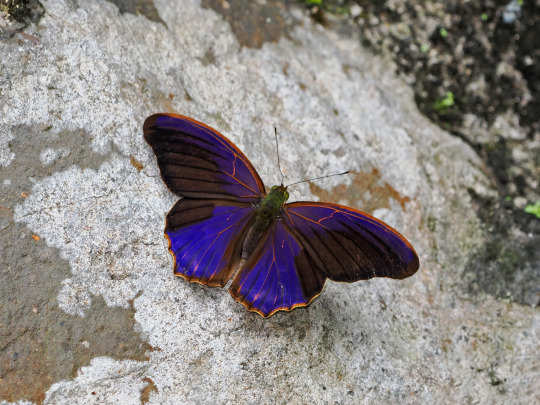
Royal Assyrian (Terinos terpander) in Bukit Lawang, North Sumatra, Indonesia.
8K notes
·
View notes
Text
Complete Medan Tour Package 5D4N Including Bukit Lawang
In addition to the Lake Toba tour package, we also have a Complete Medan Tour Package 5D4N Including Bukit Lawang. This tour package offers a tour visit to the Bukit Lawang tourist attraction.
Bahorok District, Langkat Regency is known as the habitat of the Sumatran Orang Utan which is located in the Gunung Leuser National Park area of North Sumatra.
Cheap Medan Tour Package Program Bukit Lawang 5D4N
Not only offering a tour visit to Bukit Lawang, this cheap Medan tour package also offers a tour visit to other best destinations in North Sumatra.
The leading tourist destinations to be visited consist of the Berastagi tourist attraction, Taman Simalem Resort, Bukit Indah Simarjarunjung, Lake Toba tourist attraction, Samosir and also Medan tourist attractions. What is the tour program like, we explain as follows:
First Day Tour: Bukit Lawang Bahorok
When you arrive at the arrival gate of Kulanamu Airport, you will be greeted by our representative "HORAS MEDAN". Then depart for Medan City.
Arriving in Medan, the city tour will visit the Maimun Palace, the Medan Grand Mosque, Sri Mariaman Temple and the Gunung Timur Temple. After finishing, then head to a local restaurant for lunch
After lunch, then depart for Bukit Lawang. The journey will take 3 hours by crossing rubber and palm oil plantations.
It is estimated that we will arrive at Bukit Lawang Bahorok in the evening. Upon arrival at Bukit Lawang, then head to the hotel for check-in and dinner. After dinner, rest and free program.
Second Day Tour: Bukit Lawang Jungle Trekk, Berastagi
After breakfast at the hotel, then jungle trekk through the Gunung Leuser forest. During the trekking activity, we will have the opportunity to see the habitat of Orang Utans who still live in the wild.
After finishing, then return to the hotel to shower and clean up. Then check out of the hotel and head to the restaurant to enjoy lunch.
After lunch, the journey continues to Berastagi. The journey to Berastagi will take 4 hours by crossing winding roads.
Upon arrival in Berastagi, we will stop for a moment to see the Swedaghon Pagoda of Lumbini Berastagi Park. Then depart for the hotel.
Upon arrival at the hotel, check in and rest for a while until dinner time. Your dinner will be served at a local restaurant or hotel restaurant. After dinner, rest and free program.
Third Day Tour: Taman Simalem Resort, Parapat Lake Toba
After breakfast at the hotel and the check out process, then tour to Farm Gundailing to see a premium milk-producing cattle farm
After finishing, then head to the Fruit Market to see various flowers, vegetables and fresh fruits. After finishing, then depart for Taman Simalam Resort via Kabanjahe.
Upon arrival at Taman Simalem Resort, we will invite you to tour the organic plantation, the Sidikalang premium coffee blending process and see the view of Lake Toba from the north side. Then head to the resort restaurant for lunch
After lunch, the journey continues to Parapat Lake Toba via Simarjarunjung. This trip will take four hours by crossing winding and hilly roads.
During the trip we will stop at some of the best tourist attractions such as the Sipiso-piso Waterfall tourist attraction, and Bukit Indah Simarjarunjung to enjoy ginger tea and fried bananas typical of Simalungun. It is estimated that in the afternoon we will arrive at Parapat Lake Toba.
Upon arrival in Parapat, then go directly to the hotel for the baggage check-in process and rest for a while until dinner time. Your dinner will be served at the hotel restaurant while enjoying traditional Batak music. After dinner, then rest and free program.
Day Four Tour: Samosir, Medan City
After breakfast and check out of the hotel, then head to Parapat port to cross to Samosir Island.
The crossing process will take one hour using a motorboat. Upon arrival in Samosir, then head to Tomok Village to uncover the mystery of King Sidabutar's Tomb and the legend of the beautiful Princess Anting Melala.
See Also: Medan Lake Toba Tour Package from Singapore 5 Days 4 Nights + Tour to Taman Simalem Resort
After finishing, then watch the Sigale-gale Dance performance (personal expense). This dance is one of the traditional dances of the Batak people in Samosir.
Sigale-gale is a wooden doll that can dance to the accompaniment of traditional Batak music. Next, hunt for cheap souvenirs at the Tomok Traditional Market.
After hunting for cheap souvenirs, then return to the ship for the crossing to Parapat. Upon arrival in Parapat, head straight to a local restaurant to enjoy lunch.
After lunch, the journey continues to Medan City via Siantar which will take 4 hours by crossing rubber plantations and also kerets.
Upon arrival in Siantar we will stop for a moment at Toko Paten to buy various souvenirs typical of Siantar City such as tengteng, tangtangm tingting, pangpang and so on.
After finishing the trip, continue back to Medan. Upon arrival in Medan City we will take you to a local restaurant to enjoy dinner
After dinner, then go to Kedai Ucok or Kedai Bolang to enjoy the delicious Medan durian (personal expense).
Next we will take you around for a while to enjoy the night atmosphere in Medan City such as crossing the Merdeka Walk, Kesawan and Post Office areas.
After finishing, then head to the hotel. Upon arrival at the hotel, rest and free program.
Fifth Day Tour: Shopping for Souvenirs, Airport Transfer
After breakfast and the hotel check out process, the next educational tour is to Rumah Noerlen. There you will see the process of making original marqisa syrup using traditional equipment.
After finishing, then hunt for typical Medan souvenirs such as Bika Ambon, Bolu Meranti and Durian Pancake. After hunting for souvenirs, we will take you to Kualanamu International Airport.
Once you arrive at the airport, the tour is over, see you again with our other Medan tour packages.
0 notes
Text

Royal Assyrian (Terinos terpander) in Bukit Lawang, North Sumatra, Indonesia
Source: inaturalist.org
0 notes
Text
Piedra, papel y lechuga
Hoy no he meditado. Me he levantado a las 6 de la mañana. Tampoco he hecho yoga. Tengo la ropa sucia de ayer sin lavar. Y no me ha dado tiempo. Tampoco, a hacer pranayama.
No he tenido tiempo porque me he despertado escuchando tus audios que me han roto el mundo.
Y ahora soy una piedra. Como Rubén Darío que quería volverse piedra para no sentir nada. Como él, pero yo no quiero ser una piedra. Me gustaría sentir rabia o celos, incluso miedo o tristeza.
Estoy viendo un fuego que está haciendo un vecino, porque no hay nada más. Como quien ve un programa de mierda en la tele, viendo sin ver. Ya es de noche.
Estoy intentando explicarle a una amiga lo que ha pasado. Lo intento lo mejor que puedo, pero una historia tan corta como 5 audios de whatsapp que prenden fuego a todo lo que pensabas hasta ahora, son difíciles de resumir en otros 12 audios. Con las cenizas de mi mundo, de mi mente, de la confianza y la voz, trato de explicarle qué pasa.
A nadie más que a ti te contaría esto, te contaría todo. En este mundo en llamas, tú eres la única cosa no inflamable. Y doy gracias, todos los días y ahora, por tenerte. Porque algo habré hecho bien, para tenerte.
Estoy en transición. Como la harina que se transforma en pan o se echa a perder y hay que tirarla. No sé qué pasará conmigo al final, ya os lo contaré.
Hoy me he estado acordando de la película todos los saben, porque parece que todos lo saben. Y no sólo lo saben, todos me juzgan. Hasta Ana. Menudo lunes.
Es mi vida. Todos se creen con el derecho de decirme que tenga cuidado o que me estoy metiendo en algo que es peligroso. ¿Pero, si es así, por qué no me lo dijeron antes? Y no sé si sea cierto. La vida ya me ha dado suficiente caña por hoy, no necesito saberlo.
No se cuando pasó, pero creo que fue la primera semana que estuve aquí. Tengo una mancha enorme en la mano izquierda. Se extiende por mis dedos y el tatuaje. Me la ha hecho el sol. Creo que con el limón.
Estoy pensando que igual me quiero tanto ahora que ya no queda espacio para que te pueda querer.
Creo que esto no me duele más porque no hay música. Y la música me mata. Necesitaría morir un poco ahora. Y dejar de ser una lechuga.
#asia#indonesia#North of Sumatra#sumatra#bukitlawang#Bukit Lawang#viaje#viajes#travel#trip#journey#diario#diario de viaje#bitácora#wanderlust#culpa#todos lo saben#ruben dario#poesía
16 notes
·
View notes
Video
youtube
Sumatra Indonesia 4K Drone Video
0 notes
Text
Close Encounters
The Home Stretch
Hello family and friends, Helen here, taking back control (eeep, it’s gone all political…), after the recent fantastic takeover by my sister Jo.
Sam and I parted company with Jo when she headed to the international terminal to take her flight back to the UK. With Sam’s ears still playing up, we finally gave up on diving together. So we sent our dive gear back with Jo and decided to try something different for our final ten days in Indonesia.
Sam and I flew north-west, landing in Medan in North Sumatra, the most populous city in Indonesia outside the island of Java. Having been about as far east as you can go in Indonesia just ten days ago when exploring Raja Ampat, we were now pretty much as far west as possible. We spent a couple of days in Medan planning the remainder of our Indonesian trip and wandering around. The city was bedecked with beautiful decorations in honour of the Lunar New Year, with whole streets hung with red lanterns and individual shops erecting lavish displays. On our second night in the hotel, we received a phonecall asking us to answer our room door because the staff “wanted to give us fruit”, where upon doing so two members of staff shyly handed us a red note wishing us a Happy Chinese New Year and two oranges. Adorable!

Photo Above: one of the beautiful displays in honour of the Lunar New Year
Given our love of food, we ended up doing a bit of a gastro-tour—Medan is the first place we’d been in Indonesia with a large Chinese-Indonesian (and therefore often Buddhist) population, so we found that it was incredible for vegetarians and vegans. We saw next to no foreigners, so these food spots were always aimed at locals—in fact, the Chinese-Indonesian owner of one of the vegan restaurants told us the story of visiting Ubud (the alternative yoga and arts town in Bali that we visited in November, which also had a strong vegan food scene) and how, upon walking into a vegan restaurant, he looked around in complete astonishment at the clientele and exclaimed, “where are the Chinese?!”. Given that there were so few foreigners, we were somewhat of a novelty. Case in point, when we stopped by a roadside vegetarian Makasan Padang place (Makasan Padang being a typical Sumatran cuisine, and one of Sam’s favourites from our trip), the staff requested a team photo with us.
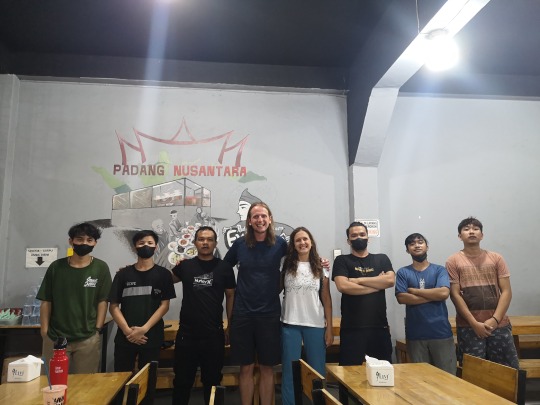
Photo Above: veggie Makasan Padang team photo!
Though Sam’s back was slowly improving, it was still causing him a fair amount of pain, so we decided to be fancy people and for the princely sum of about £15 ($19), we bought a day pass to the Marriott hotel spa to have a lovely romantic day relaxing together. We took the lifts all the way up to the spa on the seventeenth floor, our heads full of visions of our romantic day spent chatting away together in the sauna and steam room. What we didn’t account for, however, was the fact that in a Muslim-majority place, the sauna, steam room, and jacuzzi were very definitely gender-divided. So instead, during the morning when there were no men using the facilities, Sam convinced me to cheekily sneak into the men’s facilities. Later, when it got busier, we did our hardcore relaxing separately and periodically met up to swim lengths of the outdoor infinity swimming pool (complete with incredible views across the city) and giggle at the turn of events.

Photo Above: the luxurious infinity swimming pool with a view across Medan
After a couple of days eating and relaxing in Medan, we made the three-hour journey west to the rainforest village of Bukit Lawang, famous as the gateway into the jungle that is home to the Sumatran Orangutans. As the city morphed into tropical countryside, we began passing palm oil plantations, which stretched for miles along the rest of our journey. When we reached the village of Bukit Lawang itself, we were welcomed by someone from our accommodation. He hoisted our large bag onto his shoulders and led us down a small alleyway, then along a dirt track besides a river lined with rickety wooden buildings and across a narrow pedestrian suspension bridge spanning the river. On the other side, we began scaling 270 stairs, climbing high until we reached On the Rocks, our home for the next while. The lodge was nestled right next to the border of the Gunung Leuser National Park, so we picked a small, wooden cabin built into the steep side of the hill, complete with huge balcony overlooking the rainforest and a vast glassy window in the bathroom meaning we had a loo with a spectacular view. That evening, we fell asleep to a vast soundscape of rushing river, buzzing cicadas, and chattering monkeys. When we stepped onto our balcony the next morning, a troupe of Thomas’ leaf monkeys (an endemic species of primate with distinctive black and white facial markings) were climbing the trees a few metres from us and play-squabbling amongst themselves.
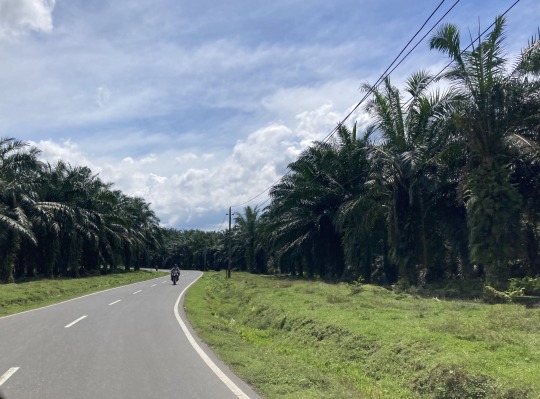

Photos Above: the palm oil plantations lining the road; serious porter skills
We spent a couple of days relaxing in the lodge, going for a wander around the village (mostly so that I could gleefully walk back and forth on as many of the rickety bridges as possible for fun), soaking up the stunning views, and relaxing into the lushness of the rainforest sounds, smells, and foliage.
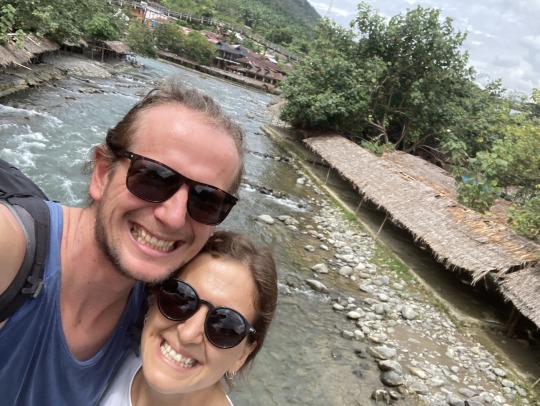
Photo Above: exploring the village
Into the Wild
On our third day there, we each packed a small rucksack and met our trekking group for the next few days up at the lodge’s restaurant. As I’m such a keen bean about all fauna, I had done my ape research beforehand. The word orangutan is, in fact, from the Indonesian, meaning “forest person”. There are three species of orangutan in the world, the Sumatran Orangutans we hoped to see being found only in Sumatra, as their name suggests. They are critically endangered, with only an estimated 14,600 remaining in the wild.
Just before we set out, a shout went up—a short way across the valley, a female orangutan and her adolescent baby were making their slow, swinging way through the trees, the mother sometimes acting as a bridge between two trees for her child to climb across. I was completely entranced by their movement, especially their seemingly outsized arms, which were far longer than their legs—orangutans can’t jump, so they always move through the trees limb to limb. As everyone joked, no need to go on the trek now!
We set off into the jungle. Our On the Rocks team was made up of an extended group—there was Ulf and Zilke, a German couple travelling with their children, Lulu (12) and Alvin (8), who were doing a shorter route than us each day, so had their own two guides, while our immediate group included Magda and Max, a couple from Germany, led by Ling and supported by Bincar. Later it would become apparent why having two guides per group was so important.
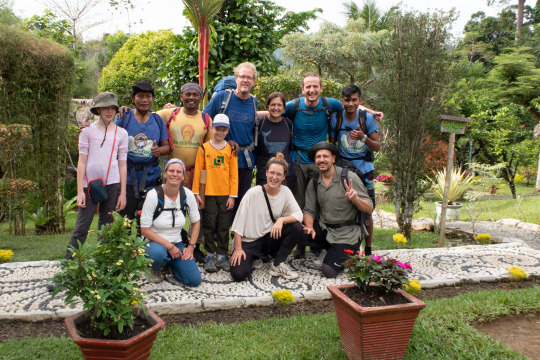
Photo Above: our extended trekking group
The trekking started gently, as we followed a trail through the jungle and Ling pointed out interesting things to us—first, the solidified gum from a gum tree, then the pungent smell of orangutans, and then a short while later, some more Thomas’ leaf monkeys who casually came down to the forest floor to check us out. We also came upon the orangutan mother and baby we had seen from the lodge and hung out below them for a while. As we walked, Ling would scan his eyes through the canopy and I could practically see his ears stood on end, so tuned in was he to his surroundings. He would periodically make orangutan noises, the sound of the female sounding like someone doing a loud kiss into the palm of their hand, while the male noise was much more like a deep gruff cough. It turned out that Ling was super experienced, having been guiding in this jungle since 1999, and it was quickly evident how much he loved the forest and how completely at home he was in it.
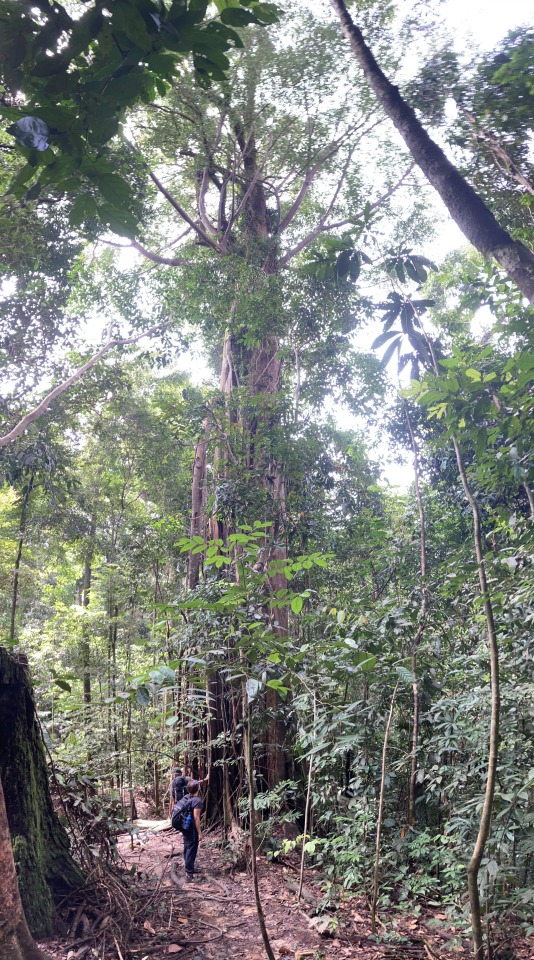
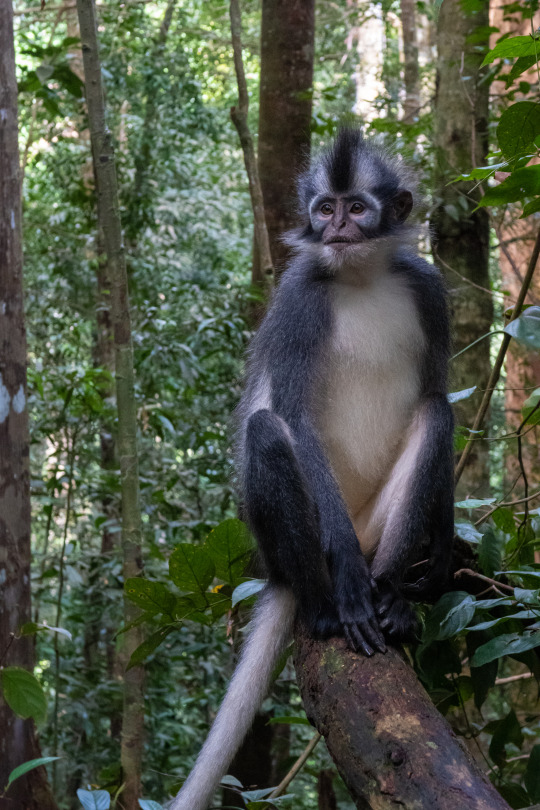
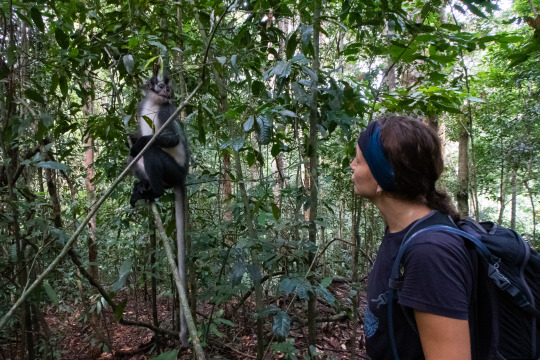
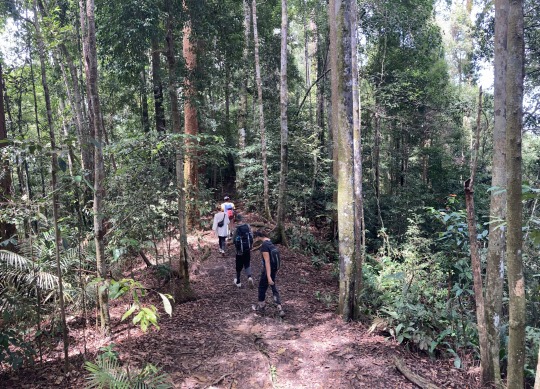
Photos Above: me gazing up at a huge gum tree; a Thomas' Leaf Monkey; making friends; walking the rainforest trail
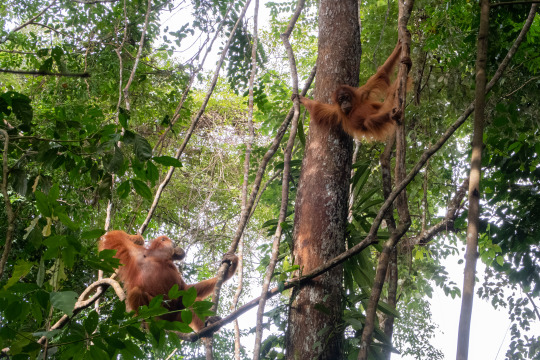

Photos Above; the mother and her baby; the mother orangutan's vast armspan
It was not long before we came across our next orangutans. This was a particularly special experience—it was an adult mother with a tiny, scraggly-looking baby clutching the fur on one side of her torso, so newly born that it’s umbilicus still hung from it, swinging in the air as the mother moved. Our guides figured that the baby was merely a day or two old, and we watched as the mother kept gently touching her fingers to her vagina and licking them because she was still bleeding from the birth. While her own fine-haired fur was a vivid russet colour, her baby looked like a pale, wrinkly little Gollum. She seemed completely unfussed by the humans peering up at her and in fact slowly swung her way towards and above us so that she passed within a few metres. I couldn’t stop staring at her, especially her face, which seemed so expressive that it was hard not to anthropomorphise her.
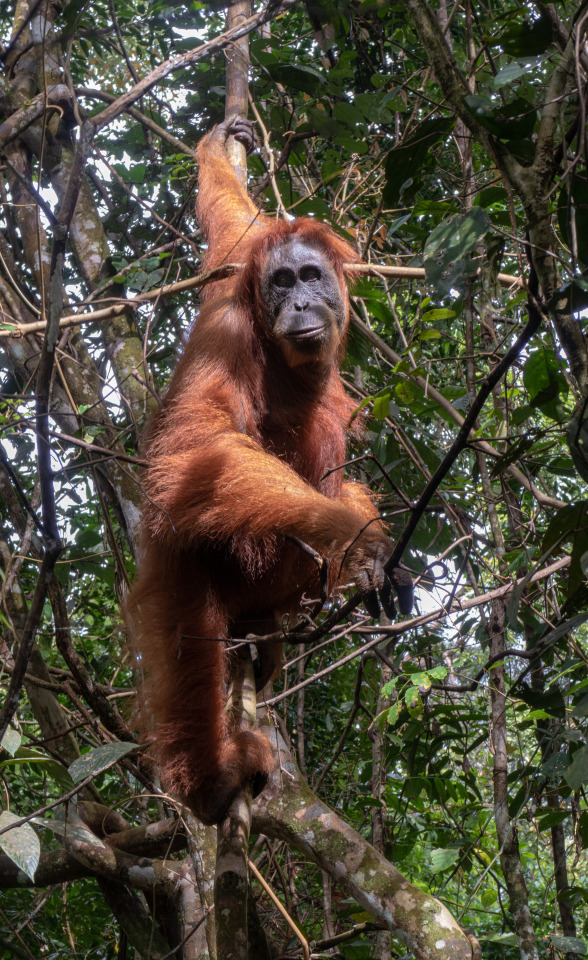
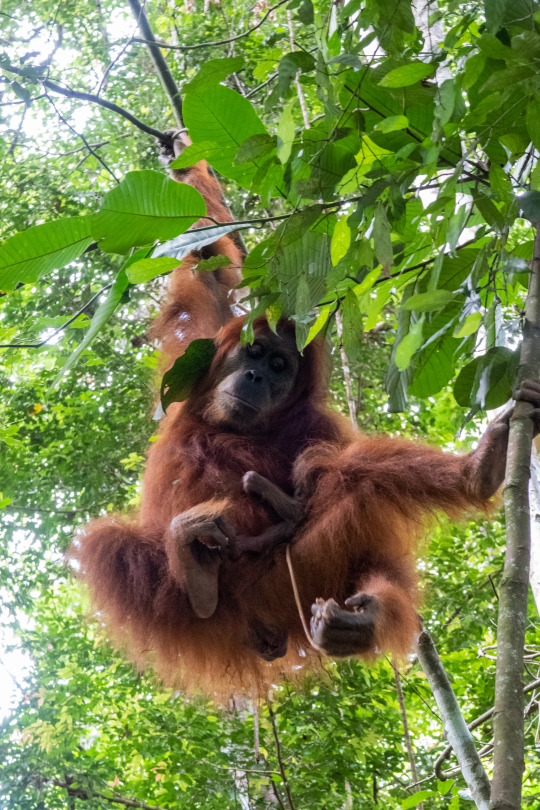
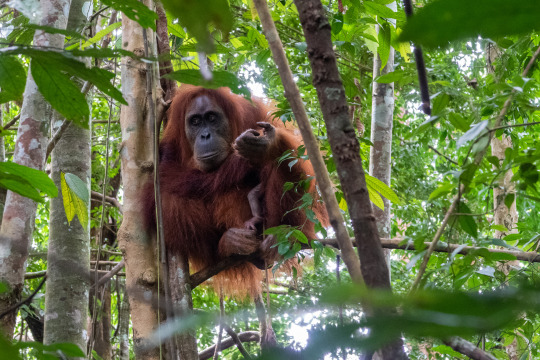

Photos Above: mama orangutan; the mother on the move, her baby clutching her side as she holds the umbilicus; chilling in the tree; inspecting the umbilicus
The second half of the trekking that day became a lot more difficult—Ling and Bincar kept up the calls of “hati hati!” (“take care!”). The terrain was at first steeply uphill and then extremely downhill, so much so that often instead of walking, we had to climb, using lianas or thick tree roots protruding from the soil as handles to help us down. By the time we reached our camp for the evening and rejoined the German family, we all felt ready for a dip in the cool water of the nearby stream. Afterwards we sat around altogether chatting, while the guides and kids carved orangutan faces into small, reddish clay pebbles from the river to create a jungle necklace. Ling handed his first carving over to me as a gift.
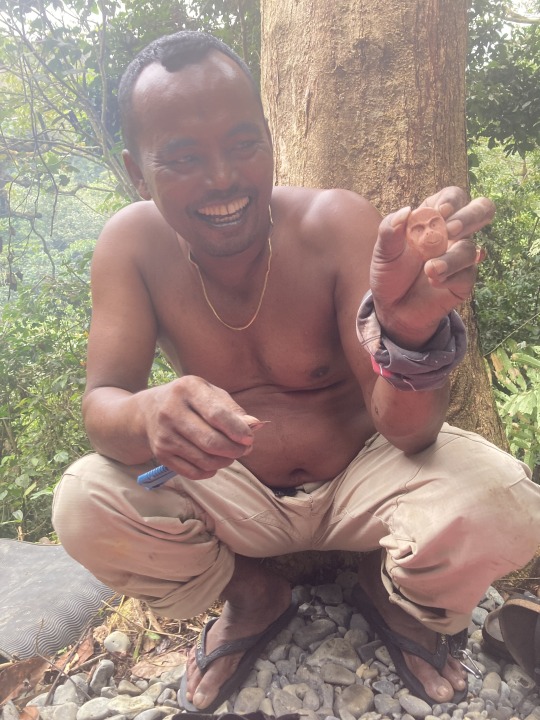
Photo Above: Ling carves me an orangutan pendant from a pebble
Our camp was made up of one roofed hut where two cooks had lit several fires to cook our dinner, plus two other roofed structures under which we would sleep for the night. With the leakproof roof, spongy mattress mats, and a large mosquito net hung over myself and Sam, it felt pretty luxurious. As the rain started that evening, we all crowded into one of the huts to be served up a feast of vegetable curry, spiced tofu and tempe, rice, and cooked vegetables. Sam and I had a great time watching the children tell raucous jokes in German—though we mostly couldn’t understand, there was plenty to appreciate in the sheer joyful giggles from the rest of the group. Though I may struggle to sleep in cities with the sound of traffic passing by, it turns out that thunderous rain on a tarp-and-thatch roof does just the trick.
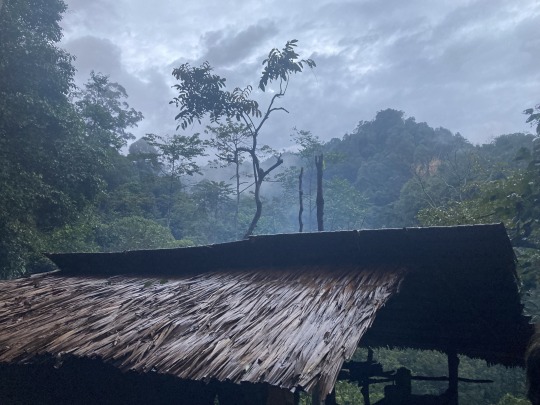
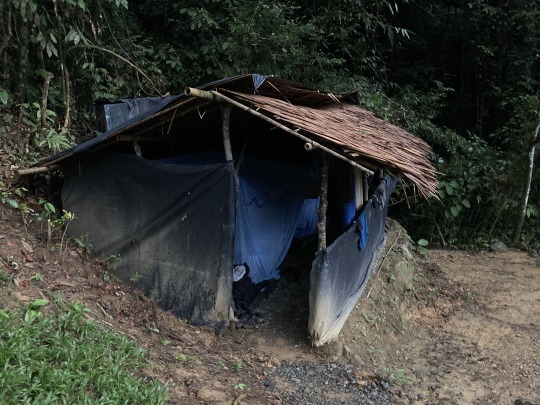
Photos Above: the cooking hut with the rainforest view behind; our bedroom for the night
Face to Face
The next day, we had a nice slow morning. Everyone sat outside, carving more orangutan pendants from pebbles, drinking tea and coffee poured from coconut husk teapots into coconut husk cups, and watching a group of Long-Tailed Macaques low in the trees around us, clearly waiting for us to leave camp before they would trawl the place to check for any leftover goodies. I managed to acquire a leech between my toes, and when I calmly pulled it off and pressed some tissue to the mini wound it had left, I caught several of the guides casting eyes at each other before one asked, was I not afraid? Turned out that they had come to expect a screeching reaction from guests.

Photo Above: a genteel rainforest breakfast
I may be nonplussed by bloodsucking leeches but when we set off trekking, I found I was extremely stiff. Because of Sam’s sore back, I was carrying almost all of our water for the day and so climbing up the steep hill, I felt a bit like a tortoise trying not to swing backwards onto its heavy shell. But after an hour or so and a couple of steep slopes up and down, I had settled back into the rhythm of things. At the top of one hill, we dumped our bags amid the tree roots and paused while Ling wandered a short way away making his usual orangutan noises to see if there was anything in the vicinity. Suddenly we heard him shout “Run, run, take your bags, run!”. We couldn’t tell if he was yelling in excitement or fear nor if he wanted us to run towards him or away. Then he came dashing up to us, shouting that a male orangutan was coming. Though humans rarely experience issues with female adults, male orangutans can be aggressive, especially when patrolling their territory, and to have a large one down on the ground was unusual. We dashed up the opposite hill, just as the big male came sloping into the clearing. Rather than following us, he paused to sit at the base of a tree, simply peering at us, perhaps to get a better scope of the situation. Ling stood well in front of us, communicating clearly about how far away we should stand and how to interpret the male’s behaviour but encouraged us to take photos. He was huge, a male named Jarwao who was at least 40 years old Ling later told us, and he was flanged—meaning he had the iconic orangutan face flaps and bulging throat sack. When I had previously researched this phenomenon, I found out that the current best guess as to their purpose is as a kind of megaphone for the calls that males make as part of declaring their territory. I couldn’t contain my excitement—I had been desperate to see a flanged male and here he was, so huge and powerful that I couldn’t tear my eyes away from him. It was barely a minute before he started coming towards us again, his long-muscular arms giving him a formidable presence. Ling held up a huge stick and hit it on the ground—making yourself big and aggressive is an important part of a guide’s role to ensure everyone remains safe. Jarwao didn’t react at all besides simply standing and watching Ling. We all hurriedly walked on, with Ling holding back to create space for us to traverse a steep downhill—he told us that orangutans are extremely fast downhill compared to humans so we trekked all the way down the vast hill before stopping besides a stream for lunch.




Photos Above: Jarwao appears; a quick snapshot with him; he continues to approach; he pauses and watches us for a while
Bincar and Ling made up little paper pouches of precooked noodles for us and then Ling kept watch looking up the hill. We had been sat about eating and chatting for a good ten minutes when Ling jumped up and told us that the male was coming down the hill. As we grabbed our bags, I saw Max look up and heard him say with shock “He’s there!”. I caught a flash of orange not far from us before everyone fled across the shallow river and began clambering up the steep trail on the other side. I was at the back of the group, with only Ling behind me. As I crossed the stream, I turned momentarily and found myself merely 4 metres from Jarwao, just as he arrived at the opposite bank. We locked eyes and I heard Ling shout a few metres to my side, fear in his voice, for me to RUN. I turned and hared it up the hill. Later, when Sam and I were chatting, we worked out that he had looked back down the hill at this very moment to see Ling throw his rucksack on the ground to distract Jarwao. I scrambled up madly and so only saw one snapshot after that: Ling running downstream between me and Jarwao, Jarwao turning to follow him. He yelled some instructions at Bincar—I presume he told him to lead us up the hill and away.
We all raced upwards not saying a word. Bincar swapped places with me so that he was bringing up the rear until we were right at the top and then he led us silently on. Besides my telling the others what had happened at the bottom, no one said a word. My mind kept turning to Ling flinging himself between me and Jarwao and I desperately hoped he was okay.
Shortly, we came to another group taking a rest and told them what had happened. The guides decided that we should leave one of their guides behind to try find Ling while their other guide and Bincar would escort us to camp. We all began climbing downwards. I was madly concentrating—with my old knee injury, I wasn’t the speediest at downhills, but I knew that injuring myself would present everyone with an even bigger problem. After a while, Ling and the other group’s guide caught up with us. I was glad to see Ling in one place, puffing madly on a cigarette and unscathed besides a bruise on one knee from falling over. He told us to keep hurrying though, so we kept moving until we reached our camp besides a large river at the bottom of the valley. Orangutans don’t come down to the river—it’s too dangerous for them to be out in the open—so the guides knew we’d be safe in the camp.
We dumped our bags, changed into our swimsuits, and slid into the eddies at the edge of the river, where the water wasn’t so strong that it would pull us downstream. After our much-needed chilly dip, we began piecing together the events of the afternoon.

Photo Above: Ling with his beautiful rainforest floral arrangement
Ling told us that though he had had many experiences with males over his more than two decades working in the jungle, it had never been like this. Usually males keep a good 15 metres away, and if they do show any aggression, they quickly fall back when faced with his own tactical “display of aggression”. On top of that, Jarwao usually stayed deep in the jungle and had never been seen this far out, a mere two days walk into the forest. Ling had also never seen a male so angry—he told us that after he used his rucksack as a decoy (he managed to grab it when he ran past), he had run in a loop to keep Jarwao away from the group and twice fell over and nearly had him catch hold of his leg. His best guess as to why Jarwao was so angry was that a group had passed by earlier in the day and potentially fed him—although guides occasionally use fruit to distract a male if in real need, simply feeding orangutans is really discouraged as over time it can change their behaviour and cause more aggression. With all this said, once it became apparent that Ling was okay and that everyone was safe, I quickly felt as though we’d had a real adventure. After all, this was nature, Jarwao was a wild animal, and we were blessed to come out unscathed, in large part due to having such an experienced and courageous guide. When I went to bed that night, I thought of Jarwao standing a few metres across the stream from me and how that vivid moment will stick with me for the rest of my life.
I was up earlier than everyone else the next morning and straight into the river for my morning dip. We had another relaxed morning, with a late breakfast then a short walk upstream to a small waterfall with a deep plunge pool, where I sat under the waterfall itself, letting the stream pummel my shoulders with a deep massage. After lunch, we packed up and watched as the guides and cooks created a special raft for us. They tethered together four black inner tubes, two large in the middle and a smaller one either side. Then they took all our bags and cooking stuff, secured them in several layers of thick plastic bagging, and tied them on top of the inflatable rings. Finally, Sam and I got into one of the large rings in the middle, sitting side by side, while Magda and Max sat in the other large tube. Ling, equipped with a long bamboo pole, sat in the front small ring and one of the cooks, also with a long guiding pole, sat in the back small ring, while Bincar perched on the edge next to Magda. And with that, our team set off down the river. It was extremely fun rafting along for a good 45 minutes, Ling and our cook using the poles to keep us from the banks and guide us through the mini rapids. I spent most of the journey either gazing around at the beauty of the rainforest covering the slopes of the valley on either side of us or giggling at the sprays of cold water that hit us whenever we bumped over rapids.


Photos Above: a waterfall massage; beside the river
When we were not too far from arriving back in Bukit Lawang, we pulled up at the riverbank. Our bags were unwrapped and we changed into our hiking gear, looked on by a mother orangutan and her roughly 4-year-old baby sat high in the trees above us. Then Ling led us once again into the forest for our final hike. Safe to say, after three days profusely sweating into our clothes, we all smelt about as strongly as orangutans. We had a fantastic last couple of hours in the rainforest, including seeing another mother, this time with a roughly 1 and a half year old baby, who swung through the branches much more tentatively than the baby we had just seen. As we neared Bukit Lawang, the sounds of the rainforest became punctuated first by a chainsaw, then by music drifting up from the village, and finally, just as we walked back into On the Rocks lodge, the afternoon call to prayer began to sound from the mosque.

Photo Above: the "after trekking" shot—just as well you can't smell us!
youtube
Video Above: a short compilation of our trek, showing footage of trekking itself, the mother orangutan with her newborn baby, and finally the very few seconds of video we got of the large male, Jarwao
Our Final Indo Hurrah
Safe to say, we all headed straight for a shower. That evening, we ate a vast spread with Max and Magda in the On the Rocks restaurant, unpicking our adventures of the last few days.
The next morning, Sam and I packed up, said our goodbyes to our trekking team, who we felt very bonded with after our shared experience, and headed back to Medan.
Sam and I had just one full day left in Indonesia, so we decided to book into a fancy hotel for a final hurrah. In reality, most of the day was spent running errands and drafting up this update but we did manage a short spa session together, a few final excellent Indo meals, quite a few glasses of complimentary wine, and a whole lot of gazing out at the amazing view of the city from our room on the twenty-third floor.

Photo Above: the spectacular view from our hotel room window
But time has a way of rolling ever onwards, and so we packed our bags, headed to the airport, and boarded a plane for Singapore—for our final few days away, we’re visiting friends who moved out here recently. As the plane took off, we both gazed out of the window. Indonesia had been vast and chaotic and humbling, and above all, oh-so good to us.
2 notes
·
View notes
Text
Gunung Leuser National Park
Gunung Leuser National Park commonly abbreviated as TNGL is one of the Natural Conservation Areas in Indonesia covering 1,094,692 hectares which is administratively located in Aceh and North Sumatra Provinces. The provinces of Aceh that were delineated by TNGL included Subulussalam District, South Aceh, Aceh Singkil, Central Aceh, Southeast Aceh, Gayo Lues, Bener Meriah, Aceh Tamiang, while North Sumatra Province which was delineated by TNGL included Dairi, Karo and Langkat Regencies.

This national park takes its name from the towering Mount Leuser with a height of 3404 meters above sea level in Aceh. This national park encompasses native ecosystems from the coast to the high mountains which are covered by dense forests typical of tropical rain, managed by a zoning system that is utilized for research, science, education, supporting cultivation, tourism and recreation.
Gunung Leuser National Park has 3 (three) functions, namely:
life support system protection preservation of plant and animal species diversity and their ecosystems sustainable use of biological natural resources and their ecosystems. Legally the existence of Gunung Leuser National Park for the first time was stated in Minister of Agriculture's Announcement Number: 811 / Kpts / Um / II / 1980 dated March 6, 1980 concerning the inauguration of 5 (five) National Parks in Indonesia, namely;
TNLeuser Mountain
TN. Ujung Kulon
TN. Gede Pangrango
TN. Baluran
TN. Komodo dragon
Based on the announcement of the Minister of Agriculture, TN area was appointed. Gunung Leuser is 792,675 ha. The Minister of Agriculture's announcement was followed up with a letter from the Directorate General of Forestry Number: 719 / Dj / VII / 1/80, dated March 7, 1980 addressed to the Gunung Leuser KPA Sub-Balai. In the letter it was stated that the status of NP management authority was granted. Gunung Leuser to Gunung Leuser KPA Sub-Balai.
The Sumatra Tropical Rainforest Heritage was accepted to the list of World Heritage Sites in 2004, making Gunung Leuser National Park also included in the list of World Heritage Sites by UNESCO, along with Kerinci Seblat National Park and Bukit Barisan Selatan National Park.
As a basis for legality in the series of forest area gazettement processes, a Minister of Forestry Decree Number: 276 / Kpts-II / 1997 concerning the Appointment of National Park has been issued. Gunung Leuser covers an area of 1,094,692 hectares located in the Special Province of Aceh and North Sumatra. In the decision mentioned that TN. Gunung Leuser consists of a combination of:
Gunung Leuser Wildlife Reserve: 416,500 hectares
Kluet Wildlife Reserve: 20,000 hectares
West Langkat Wildlife Reserve: 51,000 hectares
South Langkat Wildlife Reserve: 82,985 hectares
Sekundur Wildlife Reserve: 60,600 hectares
Kappi Wildlife Reserve: 142,800 hectares
Taman Wisata Gurah: 9,200 hectares
Protection Forest and Limited Production Forest: 292,707 hectares
In accordance with Minister of Forestry Regulation Number: P.03 / Menhut-II / 2007, currently the manager of TNGL is the Technical Implementation Unit (UPT) of the Directorate General of Forest Protection and Nature Conservation (DG PHKA) of the Ministry of Forestry, namely the Gunung Leuser National Park Office (BBTNGL) led by the Head of the Balai Besar (echelon II level).
One of the popular Tourism Objects and Objects (ODTWA) within the TNGL area is the Sumatran Orangutan Observation Center - Bukit Lawang in the Bukit Lawang Nature Tourism Area - Bohorok, Langkat Regency, North Sumatra.
On the other hand, this national park also received attention because of the rampant cases of illegal tree felling in several locations that violate environmental reservations.
Most of the GLNP area has steep topography and soil structure and texture that are vulnerable to landslides. This was proven when the flash floods that destroyed the Bukit Lawang natural tourism area a few years ago. To better protect GLNP from more severe damage, an area called the Leuser Ecosystem was formed. The area, which has an area of 2.6 million hectares, covers a flatter area around GLNP and functions as a buffer
Fauna
In this national park there are 130 species of mammals, among them are Sumatran orangutan (Pongo pygmaeus abelii), sarudung (Hylobates lar), gibbons (Hylobates syndactilus), long-tailed monkeys (Macaca fascicularis), moths (Macaca nemestriana) and boils (Hylobates lar) Presbytis thomasi). Carnivorous animals include: clouded leopard (Neofelis nebulosa), sun bear (Helarctos malayanus), Sumatran tiger (Phantera tigris Sumatraensis). Herbivorous animals in this national park are the Sumatran elephant (Elephas maximus), Sumatran rhino (Dicerorhinus sumatraensis), and sambar deer (Cervus unicolor).

It is estimated that there are around 89 endangered and protected species in the Gunung Leuser National Park, including:
Sumatran Orang utan (Pongo pygmaeus abelii)
Sumatran rhino (Dicerorhinus sumatrensis)
Sumatran tiger (Panthera tigris sumatrae)
Sumatran elephant (Elephas maximus)
Honey bear (Helarctos malayanus)
Hornbill board (Buceros bicornis)
Ajag (Cuon Alpinus)
Siamang (Hylobates syndactylus).
It is estimated that there are about 325 species of birds in the Gunung Leuser National Park, including: hornbill rhinoceros (Buceros rhinoceros). Reptiles and amphibians are dominated by venomous snakes and crocodiles (Crocodillus sp). Here there are jurung fish (Tor sp), endemic to the Alas River which can reach 1 meter long. There are butterflies here too.
Foreign tourists usually start their journey from Medan North Sumatra. For transportation they usually rent a car, one of which is the car rental service Medan 88 rent car
1 note
·
View note
Text
0858-3353-1700 (WA), Rental mobil di medan murah terbaik berkualitas
0858-3353-1700 (WA), Rental mobil di medan murah terbaik berkualitas, Sewa mobil medan kualanamu, Sewa mobil medan ke parapat, Rental mobil lebaran medan, Rental mobil medan murah, Rental mobil kualanamu medan, Rental mobil medan samosir, Rental mobil medan siantar, Rental mobil medan supir, Rental mobil di medan yang murah, Sewa mobil medan danau toba, Rental mobil medan danau toba, Rental mobil di medan Halo perkenalkan kami dari Harry Rent Cars Travel Medan. Kami menyediakan penyewaan mobil untuk tujuan
1. Bandara Kualanamu (KNO) 2. Danau Toba 3. Simajarunjung 4. Berastagi, 5. Bukit Lawang 6. Dan beragam tempat lainnya yang ada di Sumatera Utara
Adapun mobil yang dipergunakan yaitu Avanza Veloz warna hitam 2017
Biaya penyewaan cukup terjangkau.
Untuk info lebih lanjut: Harry Rent Cars Travel Medan Phone: +62 852-7060-5403 WhatsApp: +62 858-3353-1700 Alamat: Brigjen Katamso Street/Mantri Medan Sumatera Utara Indonesia
- - - - - - - - - - - - - - - - - - - - - - - - - - - - - - - - - - -
Hello, introduce us from Harry Rent Cars Travel Medan. We provide car rentals for destinations
1. Kualanamu Airport (KNO) 2. Lake Toba 3. Simajarunjung 4. Berastagi, 5. Bukit Lawang 6. And various other places in North Sumatra
The car that is used is the black Avanza Veloz 2017
Rental costs are quite affordable (Costs are quite cheap).
For more information: Harry Rent Cars Travel Medan Phone: +62 852-7060-5403 WhatsApp: +62 858-3353-1700 Address: Brigjen Katamso Street / Mantri Medan North Sumatra Indonesia

2 notes
·
View notes
Text
0858-3353-1700 (WA), Rental mobil medan berastagi danau toba bukit lawang bandara kno
0858-3353-1700 (WA) Rental mobil medan berastagi danau toba bukit lawang bandara kno, Sewa mobil medan berastagi, Rental mobil bandara medan, Rental mobil medan danau toba, Rental mobil di medan, Sewa mobil harian medan, Rental mobil medan 24 jam, Rental mobil medan per jam, Rental mobil medan kualanamu, Rental mobil medan kota, Sewa mobil medan ke danau toba, Car rental medan sumatera, Car rental di medan, Car rental at medan, Car rent medan indonesia, Car rental in medan, Car rental in medan airport, Best car rental in medan, Car rental with driver in medan, Cheap car rent in medan, Car rental with driver in medan indonesia
Halo perkenalkan kami dari Harry Rent Cars Travel Medan. Kami menyediakan penyewaan mobil untuk tujuan 1. Bandara Kualanamu (KNO) 2. Danau Toba 3. Simajarunjung 4. Berastagi, 5. Bukit Lawang 6. Dan beragam tempat lainnya yang ada di Sumatera UtaraAdapun mobil yang dipergunakan yaitu Avanza Veloz warna hitam 2017Biaya penyewaan cukup terjangkau.Untuk info lebih lanjut: Harry Rent Cars Travel Medan Phone: +62 852-7060-5403WhatsApp: +62 858-3353-1700Alamat: Brigjen Katamso Street/Mantri Medan Sumatera Utara Indonesia
- - - - - - - - - - - - - - - - - - - - - - - - - - - - - - - - - - - - - - - - - - - - - - - - - - - - - - - - - -
Hello, introduce us from Harry Rent Cars Travel Medan. We provide car rentals for destinations1. Kualanamu Airport (KNO) 2. Lake Toba 3. Simajarunjung 4. Berastagi, 5. Bukit Lawang 6. And various other places in North SumatraThe car that is used is the black Avanza Veloz 2017Rental costs are quite affordable (Costs are quite cheap).For more information: Harry Rent Cars Travel Medan Phone: +62 852-7060-5403 WhatsApp: +62 858-3353-1700 Address: Brigjen Katamso Street / Mantri Medan North Sumatra Indonesia
youtube
1 note
·
View note
Photo

Wanderer (Pareronia valeria) in Bukit Lawang, North Sumatra, Indonesia
194 notes
·
View notes
Text
Beauty Of Indonesia
Beauty Of Indonesia
Introduction
It's a massive country with diverse cultures and landscapes. Indonesia is home to some of the most beautiful beaches in the world. It has naturally amazing scenery, including volcanoes and rainforests that are teeming with wildlife. You can find monkeys everywhere on the streets, but these primates don't pose any threat to tourists who want to take pictures with them! The people are exceptionally friendly and always willing to help you out if you get lost while exploring their country. Indonesia has many cities as well as many tourist destinations that visitors will love visiting.
Indonesia is home to some of the most beautiful beaches in world.
Indonesia has a lot of beautiful beaches. Many people think that the best beaches in the world are in Australia, but Indonesia has some amazing beaches too.
Some examples of great Indonesian beaches
Bali (Gili Islands) – Gili Trawangan - one of my favorite places on earth!
Java - Borobudur Temple - stunning architecture and lush vegetation surrounding it make for an unforgettable experience.
Sumatra Island - Bukit Lawang National Park - nowhere else will you find such untouched nature like this!
Indonesia is naturally a very photogenic place.
Indonesia is naturally a very photogenic place. The volcanoes, temples and beaches are stunning, but there are also some lesser-known spots that will knock your socks off! Here are some of the best places in Indonesia to capture that perfect Instagram photo:
It’s also a great destination for foodies.
If you’re looking for a place to eat, Indonesia is a great choice. It has a wide variety of cuisines and many different types of food to choose from. Many people like Indonesian cuisine because it's very spicy and tastes good! The price is also affordable, so it makes sense to try a few dishes before deciding what your favorite ones are.
Indonesian restaurants also offer healthy options that can help you stay on track with your diet plan if you want more variety in your diet other than just American food or Italian cuisine (which aren't as popular here). You might even discover something new that was not available where you live before!
It has spectacular waterfalls.
Indonesia has a lot of waterfalls. If you're looking for an ideal place to relax, think about heading to one of these beautiful places.
Waterfalls are usually regarded as natural wonders on Earth and often have steep cliffs that make them difficult to climb without proper equipment and training. However, there are some types of falls that can be reached by hiking or swimming through the stream below them (or even jumping). These types include Angel Falls in Venezuela, Victoria Falls in Zimbabwe/Zambia/Zimbabwe/Botswana/Namibia etcetera etcetera).
The street food sold in cities is delicious and inexpensive.
Street food is a great way to try new things, meet people and learn about the local culture.
The street food sold in cities is delicious and inexpensive.
Java, Sumatra , Sulawesi and Bali are few popular tourist destinations.
Java, Sumatra , Sulawesi and Bali are the three most popular tourist destinations.
Java is the most visited island in Indonesia . It has a population of over 91 million people and it also called "the heartland" because it has a lot of natural resources like oil and gas. The country's capital city Jakarta is located here as well as Bandung which is known for its high temperatures during summer time (around 30 degrees Celsius).
Sumatra is located on an island north east side of Java Island with an area larger than any other Indonesian province except Papua New Guinea . It has more than 5 million inhabitants who live in an area smaller than Rhode Island State but larger than Tasmania (1710 sq km).
The currency used in Indonesia is Indonesian Rupiah .
The currency used in Indonesia is Indonesian Rupiah .
Indonesian Rupiah is abbreviated as IDR.
Indonesia offers many things to see and do for every type of traveler.
Indonesia is a great place for foodies, beach lovers and nature lovers alike. With its rich history and culture, Indonesia gives you the opportunity to explore many different countries in one lifetime. You can spend your time exploring temples, hiking through forests or simply relaxing on the beach with friends or family.
Indonesia has so much to offer that it will take months if not years before you run out of things to do there!
Conclusion
It’s hard to believe that Indonesia has been around for more than 3,000 years. The people of this island nation are known for their hospitality and warm smiles, so don’t be shy when you visit them! They love meeting new people from all over the world. Visit this beautiful place at low price with http://www.cubixholidays.com/ and enjoy your trip and make it memorable.
0 notes
Text
Orangutans in Bukit Lawang, North Sumatra
Orangutans in Bukit Lawang, North Sumatra

Bukit Lawang is the location of natural attractions which are part of UNESCO. Bukit Lawang stands east of the Gunung Leuser National Park and is the only breeding place for Orang Utans in Sumatra. Orangutan Orangutan Hill Lawang is a place for several Sumatran Orangutan breeding sites in the world. Many tourists are interested in visiting Bukit Lawang to see directly Sumatran Orangutans living…
View On WordPress
3 notes
·
View notes